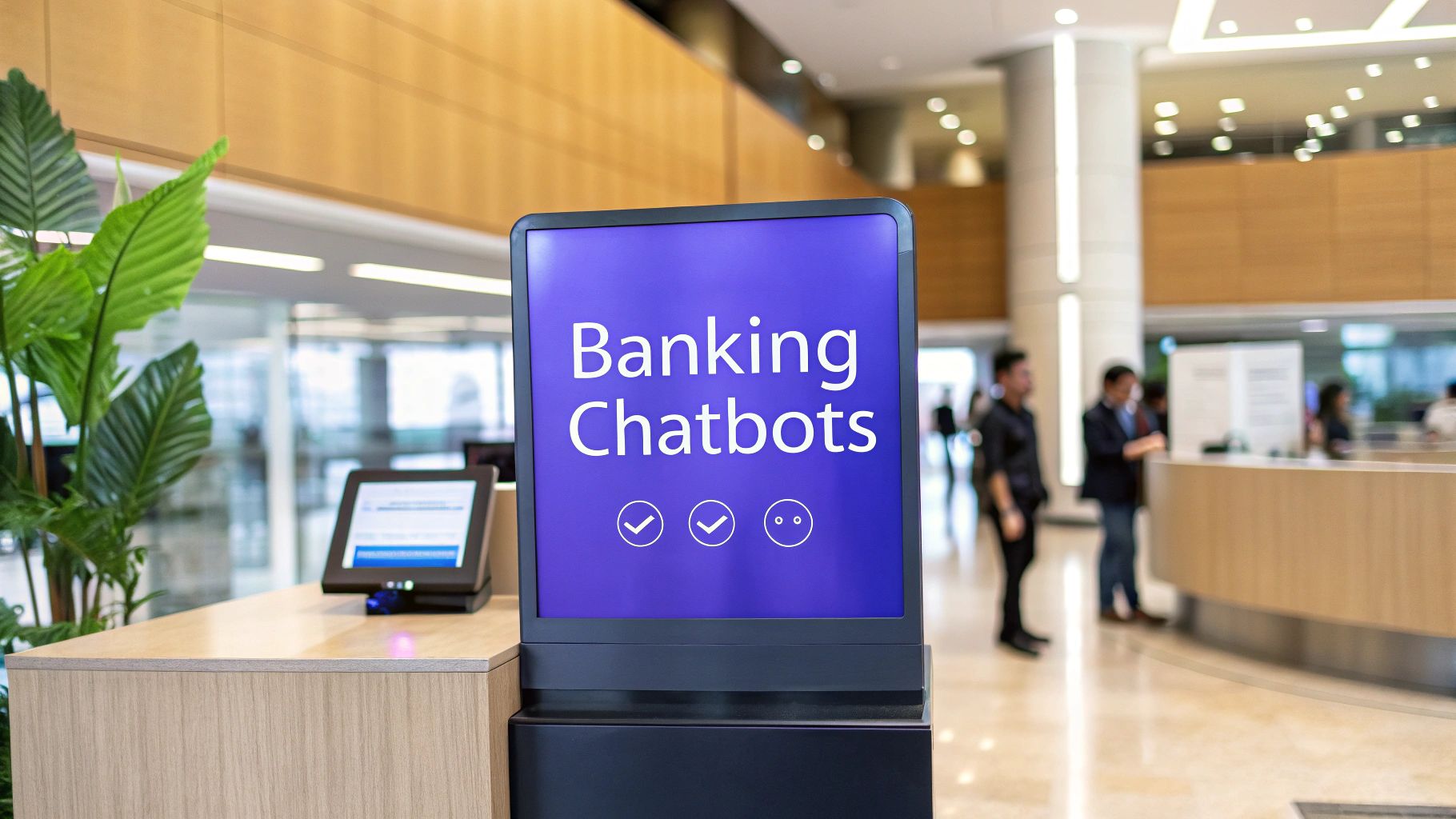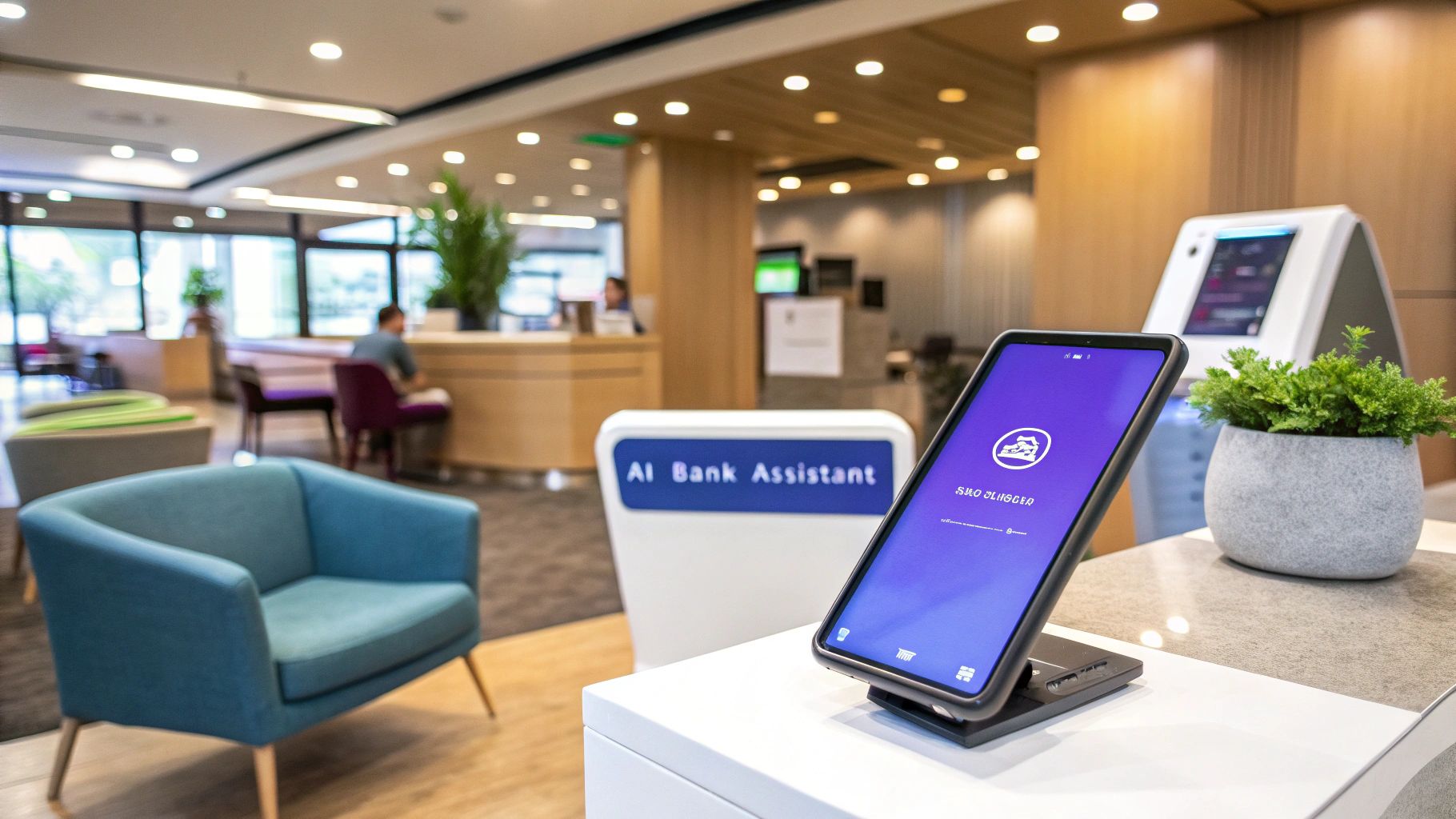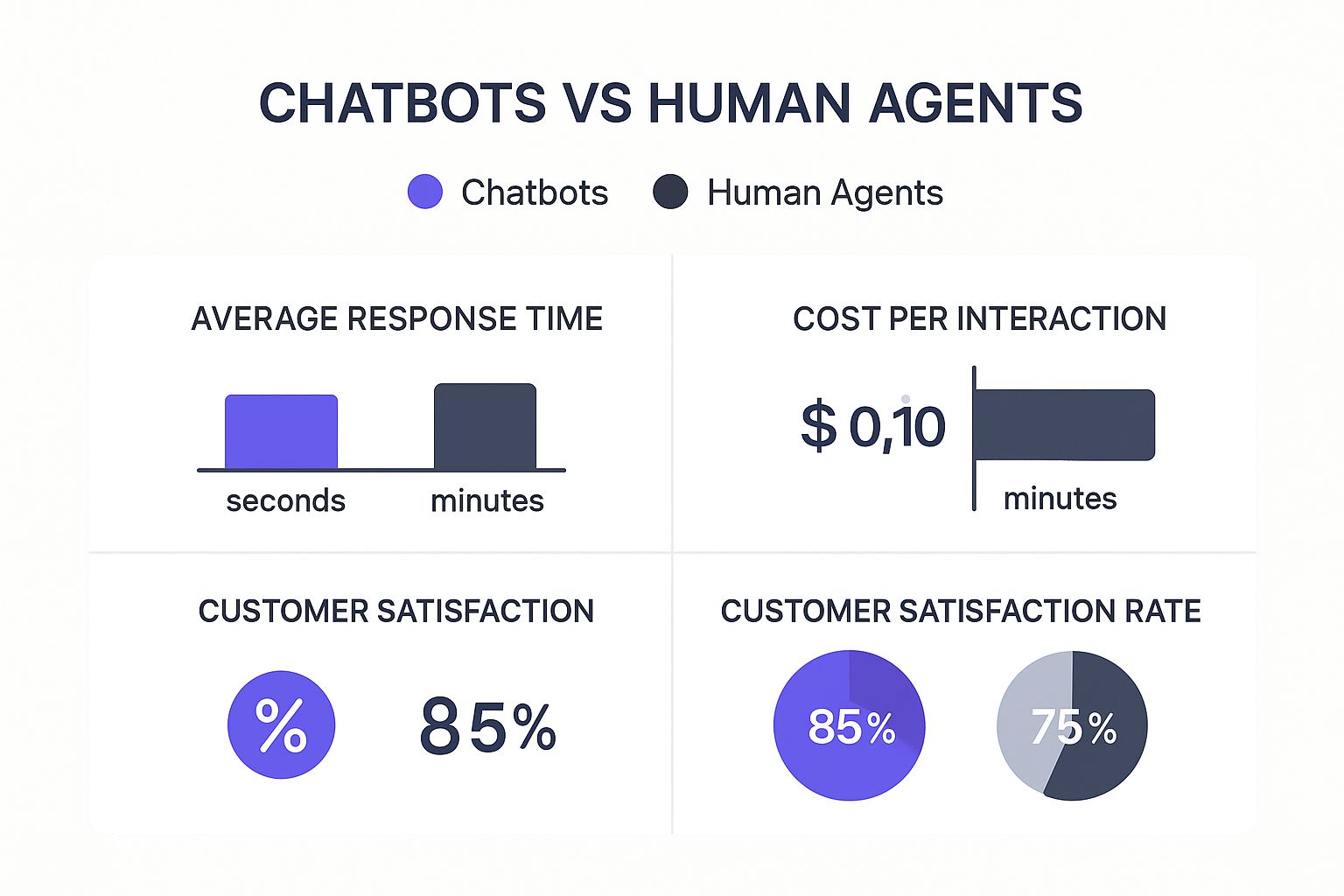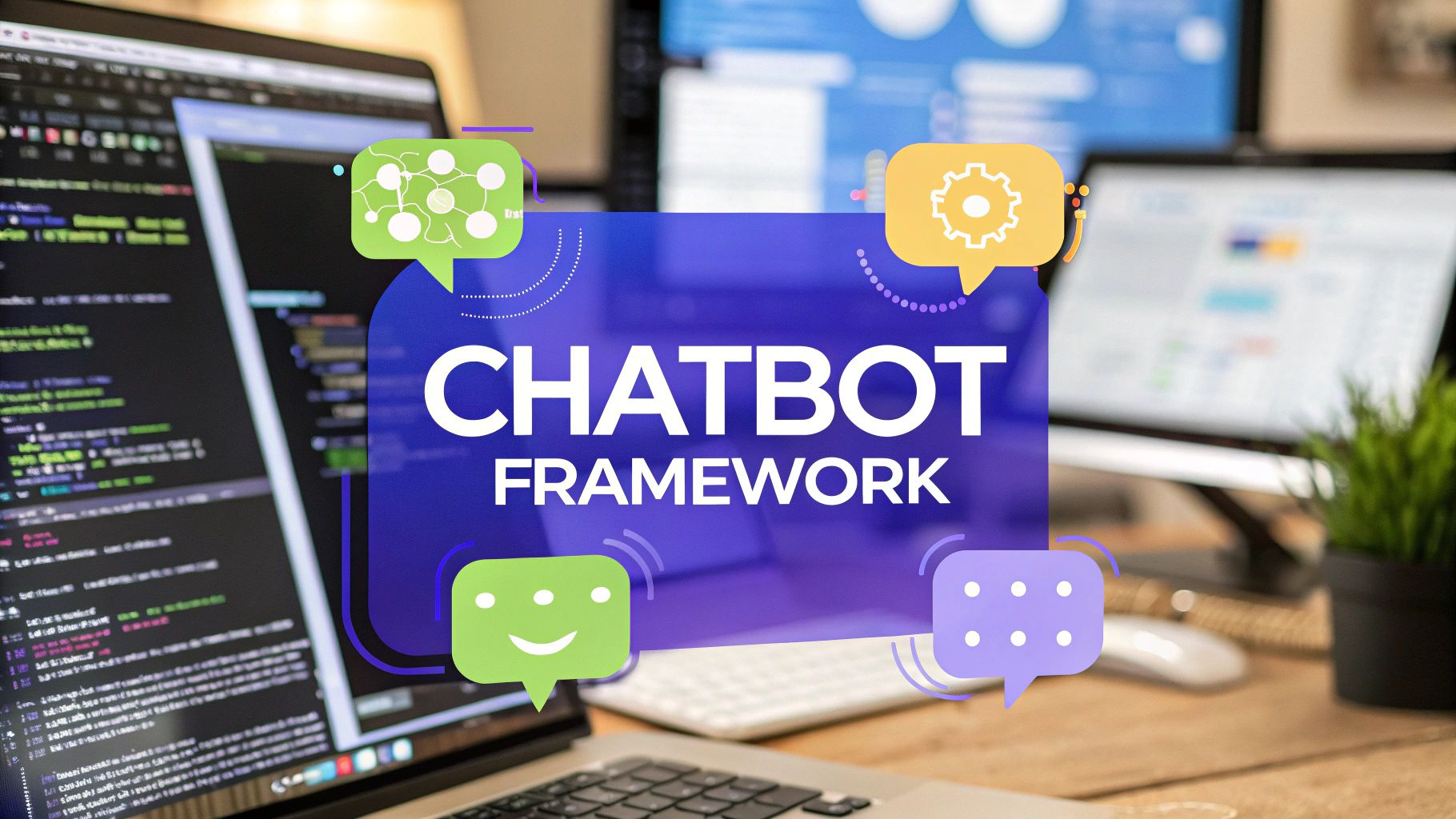Chatbots in Banking Are Changing Customer Service
Discover how chatbots in banking are transforming customer support. Learn the strategies, benefits, and real-world applications driving the change.

Remember trying to sort out a simple banking problem late at night? The old way meant waiting for business hours, getting stuck in phone menus, and just hoping you’d get a quick answer.
The new way? You get an instant answer, anytime, right from your phone or computer.
The New Standard for Banking Customer Service

The days of being tied to a bank's opening hours are fading fast. Today, chatbots in banking are stepping in as round-the-clock digital assistants, completely changing how we manage our money. They have grown from simple Q&A bots into sophisticated tools that are now a core part of the modern banking experience.
This represents a massive operational shift for financial institutions all over the world. These AI assistants are built to handle a huge volume of everyday questions at once, a task that would otherwise demand a large team of human agents. This frees up bank staff to tackle the more difficult issues that really need a human touch.
A New Era of Customer Interaction
For customers, the payoff is immediate. Instead of sitting on hold, you get instant support for common tasks. This kind of immediate access to help has quickly become the baseline expectation for most people.
What does this look like in the real world? A customer can:
- Check their account balance in a few seconds.
- Look up recent transactions without logging into an app.
- Ask about loan rates at midnight.
- Get help resetting a forgotten password instantly.
This on-demand service model is completely redefining what good customer support means in the financial world. It is all about providing accurate, secure, and immediate help whenever a customer needs it.
The adoption of these tools is a full-blown movement. In 2022, over 98 million people in the U.S. used their bank's chatbot. By 2023, these digital assistants were estimated to save banks globally a whopping $7.3 billion by cutting down the cost of each customer interaction.
This kind of efficiency is exactly why all of the top 10 largest commercial banks have made chatbots in banking a central piece of their customer service strategy. You can discover more chatbot statistics and their impact on banking to see the full picture.
How Banking Chatbots Understand Your Questions

Ever wonder how a chatbot can instantly tell you your account balance? It’s not magic, but it’s close.
Think of it like talking to a highly efficient bank teller. When you ask a person, "What's my account balance?" their brain instantly deciphers the words, understands your goal, and pulls up the right information. A banking chatbot does the exact same thing, just using code instead of neurons.
The technology making this possible is called Natural Language Processing (NLP). At its core, NLP is the bridge between everyday human language and the strict, logical instructions a computer needs to function. It lets the bot read your message, figure out what you really mean, and decide how to respond.
This is why you can type "show me my balance," "how much money is in my account," or even "current account status," and the bot knows you’re asking for the same thing. That flexibility is what makes the conversation feel natural instead of like you're just typing commands.
From Simple Rules to Smart Learning
Not all banking chatbots are built the same. They generally fall into two camps, and knowing the difference helps explain why some feel smarter than others.
On one hand, you have simple, rule-based chatbots. These are like a glorified phone tree. They are programmed with a very specific script of questions and can only offer pre-written answers. If you ask something they haven't been programmed for, they hit a wall.
On the other hand, you have advanced AI-powered chatbots. These bots use machine learning to get smarter with every conversation they have.
Machine learning allows these chatbots to learn from thousands of customer interactions. With each question, the bot refines its ability to understand different requests and provide more accurate and helpful answers over time.
This continuous learning process means AI chatbots can handle a much wider and more complicated range of questions. They can even start to anticipate what you might need to ask next.
How Your Request Is Handled Securely
So, when you ask an AI chatbot, "What's my account balance?" what is happening behind the scenes to keep your information safe? It is a fast but careful four-step process.
- Intent Recognition: First, the chatbot uses NLP to figure out your goal. It recognizes key phrases like "account balance" to understand that you want to check your funds.
- Authentication: Before it does anything else, the bot needs to know it is really you. It will trigger a secure login or multi-factor authentication, just like your main banking app would. Security always comes first.
- Data Retrieval: Once you are verified, the chatbot sends a secure, encrypted request to the bank’s internal systems to fetch your current balance.
- Response Generation: Finally, the bot takes that raw data, formats it into a clear, conversational message, and sends it back to you, often in a matter of seconds.
This whole sequence is a tightly coordinated dance between language analysis, strict security protocols, and data integration. The end result is a fast, convenient, and completely secure way to get the answers you need, right when you need them.
Real Benefits for Banks and Their Customers
When a bank brings chatbots into the mix, it is a win-win. Both the institution and the people it serves see some pretty significant advantages right away. For customers, the biggest immediate perk is convenience. Help is no longer stuck between 9 and 5.
Got a question about a weird transaction at 3 AM? Or need to check a fee on a Sunday afternoon? No more waiting. You get instant answers, right when you need them. This cuts out the classic friction of phone menus and hold music, making interactions feel direct and a whole lot less frustrating.
Gains in Operational Efficiency
For the banks themselves, the benefits are just as tangible, especially when it comes to running a smoother operation. Chatbots are a game-changer for lowering customer service costs. They can handle a massive volume of routine questions at the same time, something that would otherwise require a large team of support staff.
This isn't just about cutting costs, though. It's about being smarter with resources. When bots take care of the simple stuff, human agents are freed up to focus on the more complicated, high-value customer issues that actually require their expertise. Beyond just answering questions, banking chatbots are key to building out effective workflow automation strategies. This shift leads to better service across the board and even boosts employee satisfaction. After all, nobody enjoys answering the same password reset question a hundred times a day.
You can learn more about how an AI chatbot for customer service can reshape support operations from the ground up.

This dual benefit of making banks more efficient while giving customers faster, more accessible service is exactly why chatbot adoption has taken off. It creates a powerful cycle of improvement.
How Chatbots Measure Up for Banks and Customers
It's one thing to talk about benefits in general, but it's more helpful to see how they apply to each side of the equation. Here is a breakdown of what both banks and customers really get out of this technology.
Chatbot Benefits for Banks and Customers
As the table shows, the advantages are complementary. Banks save money and streamline their operations, which in turn fuels a better, faster, and more convenient experience for the customer.
The Scale of Chatbot Impact
The financial impact here isn't small. By 2025, the global market for banking chatbots is expected to hit around $2.1 billion, a massive jump since 2020. This growth shows just how important these tools have become.
On average, a single bank chatbot handles over 40,000 customer interactions every single month. That number alone demonstrates the key role they now play in modern customer service. As banks save on operational costs, they can reinvest that money into improving the technology, which leads to an even better customer experience down the line.
Practical Examples of Banking Chatbots in Action

It is one thing to talk about what banking chatbots can do, but seeing them in the wild is where their value really clicks. These AI assistants are way more than just glorified FAQ pages. They are actively helping customers get a handle on their finances by tackling both simple and complex tasks with speed and precision.
It all starts with the little things that used to clog up phone lines. Now, customers can instantly check an account balance or review their recent transactions right in the chat. A simple question like, "How much did I spend on groceries last week?" gets an immediate answer, saving them from having to sift through statements manually.
This instant access builds a foundation of convenience and trust. Once customers see how easy the basics are, they're much more likely to rely on the chatbot for bigger financial moves. And banks are noticing, expanding their bot's capabilities far beyond simple account info.
Moving Beyond Simple Questions
Today’s more advanced chatbots in banking are built to handle much heavier lifts. They can guide people through processes that once required filling out piles of paperwork or booking an appointment with a loan officer. It is a perfect example of how AI can take historically complicated financial tasks and make them feel straightforward.
Take the loan application process, for instance. A chatbot can:
- Educate Users: Explain the difference between loan types, clarify what is needed to qualify, and provide up-to-date interest rates.
- Assist with Applications: Walk someone through the initial application step-by-step, making sure every required field is filled out correctly.
- Send Reminders: Automatically send notifications for submitting documents or for upcoming payment due dates, keeping the whole process moving.
This kind of structured support makes something like applying for a mortgage feel way more approachable and transparent.
Proactive Financial Guardians
One of the most powerful roles for a banking chatbot is acting as a proactive financial guardian. They serve as a vigilant assistant, constantly monitoring for strange activity and offering helpful insights based on a user's spending habits.
For example, a chatbot can spot and flag potentially fraudulent activity in real time. If it sees a suspicious login from a new device or an unusually large purchase, it can shoot a notification to the customer right away. This gives the user the chance to either confirm the transaction or freeze their account on the spot, stopping fraud before it happens.
By analyzing transaction patterns, chatbots can spot unusual spending and send immediate alerts. This rapid response is a critical layer of modern account security.
But it is not just about security. These bots are also becoming personalized financial coaches. They might analyze spending habits and point out a sudden jump in subscription costs, or suggest simple ways to stick to a budget. Some bots, like NOMI from the Royal Bank of Canada, even find spare cash in a customer's account and suggest moving it into savings.
These small, data-driven nudges help people make smarter financial decisions without having to track every single penny themselves. From answering a quick balance check to offering personalized savings advice, chatbots are becoming necessary tools that actively help customers reach their financial goals.
Navigating Implementation Challenges and Risks
While the benefits are compelling, putting chatbots in banking into practice is far from a simple plug-and-play affair. Financial institutions have to clear some very specific hurdles, and it all starts with a great respect for customer trust.
The biggest one? Data security and privacy. Banks are guardians of incredibly sensitive personal information. Any system they plug in has to be a fortress. A data breach isn't just bad PR; it can be catastrophic for a bank's reputation and its customers' financial lives. This means any chatbot project must be built from the ground up with robust encryption, secure authentication, and iron-clad data handling protocols.
Meeting Strict Regulatory Standards
Beyond general security, banks live in a world of intense regulation. Their chatbots have to be designed to navigate a complex web of financial rules, from customer identification (KYC) to anti-money laundering (AML) protocols. Getting this wrong can lead to crippling penalties.
When thinking through the potential pitfalls, it's important to keep the regulatory situation in sharp focus, as the CFPB's issue spotlight on bank use of AI chatbots makes clear. Compliance can't be an afterthought; it has to be baked into the development process from day one. You can get a better sense of the technical side of things when you look into how to add a chatbot to your website.
Then there’s the initial investment. Let's be honest: building a truly smart, secure, and compliant banking chatbot takes a significant commitment of resources for development, integration, and all the maintenance that comes after launch.
The Human Handoff and Bot Intelligence
A perfect chatbot conversation feels like magic. A failed one is just plain frustrating. One of the most common breaking points is a chatbot that gets stumped by a difficult question and leaves the customer in a dead end.
A seamless and immediate handoff to a human agent is non-negotiable. If a chatbot hits its limit, it must be able to instantly connect the customer with a person who can solve their problem without forcing them to start over.
This brings up another challenge: building a bot that can actually read the room. A customer might express frustration in subtle ways, and a bot needs enough sophistication to pick up on those cues. It has to know when to respond with a more empathetic tone or, even better, when to get a human involved.
Despite these hurdles, the momentum behind this technology is undeniable. The broader AI chatbot market, which includes banking, is expected to surge from around $10–$15 billion in 2025 to nearly $47 billion by 2029. This explosive growth reflects the massive demand for smarter automation and better customer service in finance.
The Future of Conversational Banking
The journey for chatbots in banking is really just getting started. The next wave of innovation will shift these assistants from reactive problem-solvers to proactive financial partners, woven directly into a customer's daily life.
The first big leap is hyper-personalization. Imagine a chatbot that does not just answer your questions but actually analyzes your spending habits to offer specific advice. It might suggest a better savings plan based on your income or alert you to a way to cut down on recurring bills, acting as your own personal finance coach.
Evolving Toward Smarter Conversations
Future chatbots will also communicate in much more natural ways. With the rise of voice technology, you will soon be able to manage your money just by talking, whether you're at home or in the car. This shift will make banking feel even more seamless and accessible.
These bots are also becoming more emotionally intelligent. Advanced AI will soon be able to pick up on signs of user frustration or confusion in a conversation. This lets the chatbot adjust its tone or, more importantly, know exactly when to bring a human agent into the loop for a smoother experience. Getting this right means following established guidelines, and you can learn more about effective design by reading up on chatbot best practices.
The ultimate vision is a fully connected and conversational banking experience, where AI assistants are central to helping people manage their money and achieve their financial goals with confidence.
These advancements are not just hypotheticals; they confirm that chatbots in banking are far from a temporary trend. They're a foundational technology that will continue to shape the future of finance, making it more personal, intuitive, and supportive for everyone.
Got Questions About Banking Chatbots?
Even with all the clear wins, it is smart to be a little skeptical. Many people wonder if their data is truly safe, what happens when a bot gets stuck, and whether robots are about to take over every customer service job.
Let's clear up a few of the most common concerns.
Are My Financial Details Safe with a Chatbot?
Absolutely. Security isn't just a feature; it's the entire foundation. Banking chatbots are built with the same hardcore security measures you'd find on your bank’s official website or mobile app.
We're talking about heavy-duty end-to-end encryption that shields your data in transit and multi-factor authentication to make sure it is really you before any sensitive info gets shared.
- Every single conversation is encrypted.
- Bots always require secure verification before pulling up account details.
- They are designed from the ground up to comply with strict financial regulations.
Think of a chatbot not as some separate, less-protected tool, but as a secure digital extension of your bank. Financial institutions pour massive resources into making sure these interactions are completely locked down.
What Happens If a Banking Chatbot Can't Answer My Question?
A well-designed chatbot knows its own limits. If you throw it a curveball or if it senses you're getting frustrated, it won't just leave you hanging with a "Sorry, I don't understand."
Instead, it is programmed for a seamless human handoff.
The chatbot will smoothly transfer your entire conversation, context and all, directly to a live customer service agent. This way, you don't have to repeat yourself, making the transition quick and painless.
Are Chatbots Replacing Human Bank Tellers?
Nope, they're not replacing people, they're augmenting them. Chatbots are taking over the repetitive, high-volume stuff like balance inquiries and password resets.
This shift actually frees up human tellers and support staff to tackle the more difficult problems that require empathy and critical thinking. Think handling a tricky disputed transaction or offering in-depth financial advice. It makes the human side of banking more valuable, not obsolete.
Ready to improve your customer support and automate routine tasks? Chatiant allows you to build a custom AI agent trained on your own data. Explore how you can create an intelligent assistant for your business at https://www.chatiant.com.


